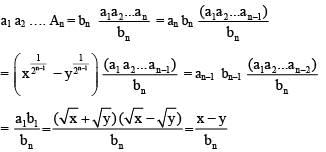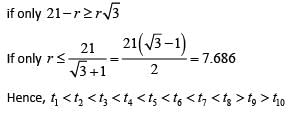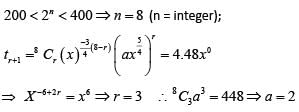Mathematics Exam > Mathematics Tests > Topic-wise Tests & Solved Examples for Mathematics > Test: Binomial Theorem - 6 - Mathematics MCQ
Test: Binomial Theorem - 6 - Mathematics MCQ
Test Description
20 Questions MCQ Test Topic-wise Tests & Solved Examples for Mathematics - Test: Binomial Theorem - 6
Test: Binomial Theorem - 6 for Mathematics 2024 is part of Topic-wise Tests & Solved Examples for Mathematics preparation. The Test: Binomial Theorem - 6 questions and answers have been
prepared according to the Mathematics exam syllabus.The Test: Binomial Theorem - 6 MCQs are made for Mathematics 2024 Exam. Find important
definitions, questions, notes, meanings, examples, exercises, MCQs and online tests for Test: Binomial Theorem - 6 below.
Solutions of Test: Binomial Theorem - 6 questions in English are available as part of our Topic-wise Tests & Solved Examples for Mathematics for Mathematics & Test: Binomial Theorem - 6 solutions in
Hindi for Topic-wise Tests & Solved Examples for Mathematics course. Download more important topics, notes, lectures and mock
test series for Mathematics Exam by signing up for free. Attempt Test: Binomial Theorem - 6 | 20 questions in 60 minutes | Mock test for Mathematics preparation | Free important questions MCQ to study Topic-wise Tests & Solved Examples for Mathematics for Mathematics Exam | Download free PDF with solutions
Test: Binomial Theorem - 6 - Question 1
{an} and {bn} be two sequences given by  for all n∈N, then a1 a2 a3 … an is equal to
for all n∈N, then a1 a2 a3 … an is equal to
 for all n∈N, then a1 a2 a3 … an is equal to
for all n∈N, then a1 a2 a3 … an is equal to
Detailed Solution for Test: Binomial Theorem - 6 - Question 1
| 1 Crore+ students have signed up on EduRev. Have you? Download the App |
Detailed Solution for Test: Binomial Theorem - 6 - Question 3
Test: Binomial Theorem - 6 - Question 4
If Zr, r = 1, 2, ...,100 are the roots of  then the value of
then the value of 
Detailed Solution for Test: Binomial Theorem - 6 - Question 4
Detailed Solution for Test: Binomial Theorem - 6 - Question 5
Detailed Solution for Test: Binomial Theorem - 6 - Question 6
Test: Binomial Theorem - 6 - Question 7
The sum rCr + r+1Cr + r+2Cr + .... + nCr (n > r) equals
Detailed Solution for Test: Binomial Theorem - 6 - Question 7
Test: Binomial Theorem - 6 - Question 8
The expansion [x2 + (x6 - 1)1/2]5 + [x2 - (x6 - 1)1/2]5 is a polynomial of degree
Detailed Solution for Test: Binomial Theorem - 6 - Question 8
Detailed Solution for Test: Binomial Theorem - 6 - Question 9
Detailed Solution for Test: Binomial Theorem - 6 - Question 10
Detailed Solution for Test: Binomial Theorem - 6 - Question 11
Detailed Solution for Test: Binomial Theorem - 6 - Question 12
Test: Binomial Theorem - 6 - Question 13
The number of irrational terms in the expansion of (21/5 + 31/10)55 is
Detailed Solution for Test: Binomial Theorem - 6 - Question 13
Test: Binomial Theorem - 6 - Question 14
The number of terms in the expansion of (2x + 3y− 4z)n is
Detailed Solution for Test: Binomial Theorem - 6 - Question 14
Detailed Solution for Test: Binomial Theorem - 6 - Question 15
Test: Binomial Theorem - 6 - Question 16
If (1 + ax)n = 1 + 8x + 24x2 + ….., then the values of a and n are equal to
Detailed Solution for Test: Binomial Theorem - 6 - Question 16
Test: Binomial Theorem - 6 - Question 17
The product of middle terms in the expansion of  is equal to
is equal to
Detailed Solution for Test: Binomial Theorem - 6 - Question 17
Detailed Solution for Test: Binomial Theorem - 6 - Question 18
Test: Binomial Theorem - 6 - Question 19
The sum of the binomial coefficients in the expansion of (x−3/4 + ax5/4)n lies between 200 and 400 and the term independent of x equals 448. The value of a is
Detailed Solution for Test: Binomial Theorem - 6 - Question 19
Detailed Solution for Test: Binomial Theorem - 6 - Question 20
|
27 docs|150 tests
|
Information about Test: Binomial Theorem - 6 Page
In this test you can find the Exam questions for Test: Binomial Theorem - 6 solved & explained in the simplest way possible.
Besides giving Questions and answers for Test: Binomial Theorem - 6, EduRev gives you an ample number of Online tests for practice



















 is its
is its






 the coefficient of x−10 will be
the coefficient of x−10 will be 



 it has 12 terms in it’s expansion ,
it has 12 terms in it’s expansion ,

 term will be the middle term.
term will be the middle term.

















